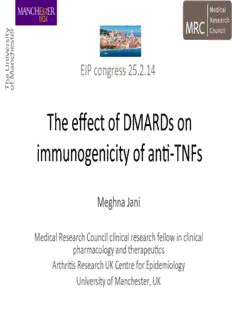
Jani Meghna PDF
Preview Jani Meghna
EIP congress 25.2.14 The effect of DMARDs on immunogenicity of an6-‐TNFs Meghna Jani Medical Research Council clinical research fellow in clinical pharmacology and therapeu6cs Arthri6s Research UK Centre for Epidemiology University of Manchester, UK Biologics in clinical prac6ce • Biologics have transformed the treatment of RA, PsA, AS over the last decade • Costs ≈ £10,000 per pa6ent/year; serious adverse events • 30-‐40% will not respond to an6-‐TNFs • Some pa6ents do not respond at all (primary non response) • Some lose response (secondary non response) • Mechanisms underlying these treatment failures are not en6rely clear Molecular structure of an6-‐TNF drugs with poten6al immunogenic sites Jani M et al. Rheumatology 2014;53:213-222 Clinical consequences of immunogenicity Efficacy • Neutralizing an6body produc6on leading to inefficacy Safety • Infusion site reac6ons • Phenomena mediated by immune complexes (serum sickness, bronchospasm) in RA/ Crohn’s • Possible increase in arterial and venous thromboembolism1 1 Korswagen LA et al. Arthri6s Rheum 2011; 63:877-‐83 Factors influencing immunogenicity Schellekens H. Nat Rev Drug Discov 2002:457–6262 Treatment related factors Jani M et al. Rheumatology 2014;53:213-‐222 Decision to start disease modifying an6-‐rheuma6c drugs (DMARD) • Ohen depends on adverse reac6ons, comorbidi6es, pa6ent preference • RA pa6ents should be on MTX alongside an6-‐ TNF drug • In ankylosing spondyli6s-‐ not rou6nely prescribed • In psoriasis-‐ discon6nued prior to star6ng biologic Effect of MTX in IFX treated RA pa6ents MTX + INF ° No MTX HACA 53% (no MTX) vs. 15% (with MTX) Maini R et al. Arthri6s & rheuma6sm 1998; 41:1552-‐63 MTX lowering ADA levels 106 RA pa6ents -‐> 6 months MTX lowered ADAb levels, unlike any other DMARD Bendtzen K et al. Arthri6s Rheum 2006;54:3782-‐9 “Development of An6drug An6bodies against Adalimumab and associa6on with Disease Ac6vity & Treatment Failure during long-‐term follow-‐up” 272 consecu6ve RA pa6ents: 148 (55%) completed follow-‐up, median FU 156 weeks Fulfilled ACR 1987 revised criteria for RA & DAS28 ≥3.2 (ac6ve disease), despite treatment with 2 DMARDs Treated with adalimumab (± DMARDs) 40mg subcut TNF naïve or switchers → Adalimumab Bartelds et al. JAMA. 2011;305(14):1460-‐8
Description: